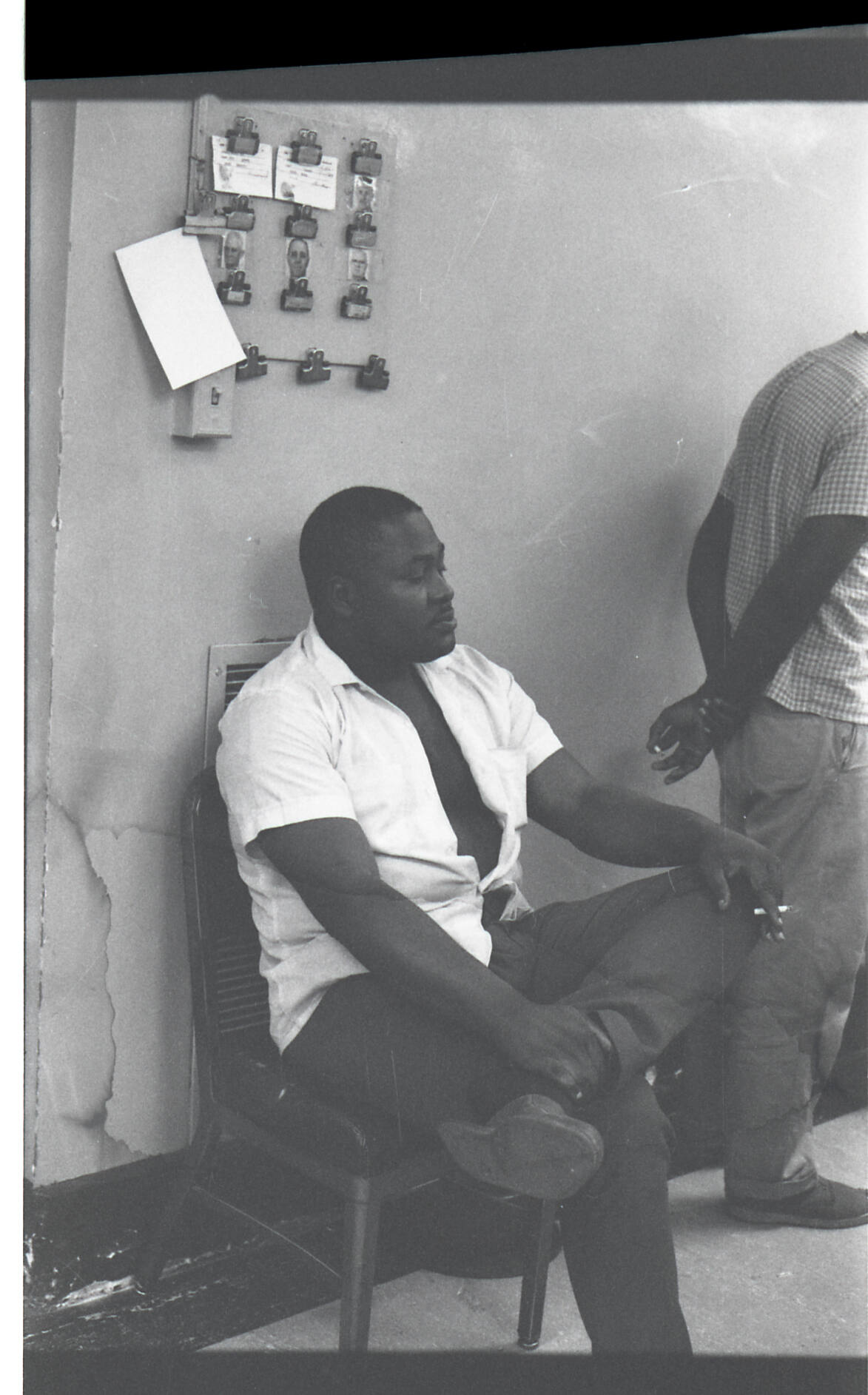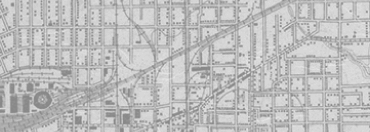


Back
Image inside courthouse during hearing related to 1964 civil rights protest
Black and white negative image taken inside a courthouse during a hearing related to a June 1964 civil rights protest at the Piccadilly Cafeteria on Commerce Street in downtown Dallas. The hearing was being held at the same time the civil rights protest was still ongoing. The image shows an unknown African American man seated in a chair with his legs crossed and holding a cigarette. He appears to be in a hallway or small room of the courthouse. Above him posted on the wall are several identification cards and photos of unknown individuals. While the identity of the man is unknown, it is likely that he was one of the protestors. Piccadilly Cafeteria management tried to stop the ongoing protest through legal action. Lawyers on both sides argued over a restraining order that forced protestors to stay fifty feet away from the cafeteria entrance. Over the course of twenty-eight days, a total of seventeen demonstrators were arrested, although all charges were dropped when the dispute was settled by an independent mediator out of court.This is one of many surveillance photos taken by the Dallas County Sheriff's Department during the month-long civil rights protest at the Piccadilly Cafeteria in Dallas, Texas, in 1964.
Image inside courthouse during hearing related to 1964 civil rights protest
06/16/1964
Film
1 x 1 1/2 in. (2.5 x 3.8 cm)
Dallas County Sheriff's Department Collection/The Sixth Floor Museum at Dealey Plaza
2005.010.0153.0001
One of the most prominent and sustained civil rights protests in Dallas history occurred at the downtown Piccadilly Cafeteria at 1503 Commerce Street. Beginning May 30, 1964, activists interested in desegregating the popular cafeteria peacefully protested at the site for twenty-eight consecutive days. During that time, seventeen demonstrators were arrested for “disturbing the peace,” ranging from a sixteen-year-old high school student to a thirty-seven-year-old housewife. The protest brought Dallas national media attention, with articles appearing in publications such as the New York Times, Washington Post, Wall Street Journal and Los Angeles Times. Local newspaper, The Dallas Morning News, ran approximately twenty-five stories on the demonstration over the course of one month. Although initiated by the actions of Dallas resident Clarence Broadnax, who was arrested and allegedly threatened by Dallas police officers after refusing to leave the cafeteria in May 1964, the actual demonstration was principally organized by Dallas minister Earl Allen, then pastor of Highland Hills Methodist Church and a local leader with the Congress of Racial Equality. This CORE demonstration in Dallas followed the same basic rules as other restaurant protests throughout the south at that time. Each day, especially during the weekday lunch rush, peaceful demonstrators would join the line outside and wait to be refused service at the door before going to the back of the line and trying again. This resulted in a noticeable slowdown in business, causing the cafeteria to lose money—one of the only ways that civil rights organizations could effectively change long-standing racist segregation policies. Other protestors supported those in line by chanting, singing or holding up signs and marching up and down Commerce Street to attract attention. While crowds of up to 150 people would sometimes gather to watch the demonstration in action, the situation also attracted groups of white segregationists, who heckled the demonstrators and brandished Confederate battle flags in counter protest. While this elevated the threat of violence—and Dallas judge Dee Brown Walker once called the protest “an explosive situation”—no violent altercations occurred during the twenty-eight-day demonstration. Piccadilly Cafeteria chain founder and president T.H. Hamilton told The Dallas Morning News one week into the demonstration: “We are trying to go along as fast as we can, but we do not like being pushed.” Rather than immediately change its “whites only” serving policy, the cafeteria attempted to solve the crisis through legal action. For the duration of the protest, lawyers on both sides of the argument were in and out of Dallas courtrooms. Despite a restraining order that forced protestors fifty feet away from the entrance, the pattern of slowing down lunch traffic continued. After nearly a month of persistent daily protests, the demonstration finally reached a conclusion, through a very unlikely source. A forty-two-year-old white aeronautics engineer in Dallas stepped forward when his two teenage sons were arrested for participating in the demonstration. He took it upon himself to organize a private meeting with both parties, and a resolution was reached. The result: Piccadilly Cafeteria would immediately begin serving African Americans as soon as President Lyndon Johnson signed the upcoming civil rights legislation. The daily protests would cease immediately, and all charges against those who had been arrested during the protest would be dropped. Two and half hours after President Johnson signed the Civil Rights Act on July 2, 1964, an African American minister was served at the cafeteria without incident. When questioned by reporters afterwards, the Rev. John Bethel said simply, “Everyone was polite, and the food was good.” That month, Time magazine reported: “Throughout the South, from Charleston to Dallas, from Memphis to Tallahassee, segregation walls that had stood for several generations began to tumble in the first full week under the new civil rights law.” After twenty-two years of operation in downtown Dallas, the Piccadilly Cafeteria on Commerce Street closed in October 1977. The southeastern cafeteria chain, founded in 1944, remains in business with around 30 locations still in operation as of 2021. – Stephen Fagin, Curator
The Sixth Floor Museum at Dealey Plaza received two file drawers of Jack Ruby-related material from the Dallas County Sheriff's Department in 2005. At the back of one of the file drawers was a stack of black and white photographs which turned out to be survelliance photographs taken by Dallas deputy sheriffs of a twenty-eight-day civil rights protest at the Piccadilly Cafeteria on Commerce Street in downtown Dallas. - Stephen Fagin, Curator

Image inside courthouse during hearing related to 1964 civil rights protest
Black and white negative image taken inside a courthouse during a hearing related to a June 1964 civil rights protest at the Piccadilly Cafeteria on Commerce Street in downtown Dallas. The hearing was being held at the same time the civil rights protest was still ongoing. The image shows an unknown African American man seated in a chair with his legs crossed and holding a cigarette. He appears to be in a hallway or small room of the courthouse. Above him posted on the wall are several identification cards and photos of unknown individuals. While the identity of the man is unknown, it is likely that he was one of the protestors. Piccadilly Cafeteria management tried to stop the ongoing protest through legal action. Lawyers on both sides argued over a restraining order that forced protestors to stay fifty feet away from the cafeteria entrance. Over the course of twenty-eight days, a total of seventeen demonstrators were arrested, although all charges were dropped when the dispute was settled by an independent mediator out of court.This is one of many surveillance photos taken by the Dallas County Sheriff's Department during the month-long civil rights protest at the Piccadilly Cafeteria in Dallas, Texas, in 1964.
Image inside courthouse during hearing related to 1964 civil rights protest
06/16/1964
Protests
Photographs
Civil rights
Trials
Piccadilly Cafeteria
Dallas County Sheriff's Department
Dallas
Film
1 x 1 1/2 in. (2.5 x 3.8 cm)
Dallas County Sheriff's Department Collection/The Sixth Floor Museum at Dealey Plaza
2005.010.0153.0001
One of the most prominent and sustained civil rights protests in Dallas history occurred at the downtown Piccadilly Cafeteria at 1503 Commerce Street. Beginning May 30, 1964, activists interested in desegregating the popular cafeteria peacefully protested at the site for twenty-eight consecutive days. During that time, seventeen demonstrators were arrested for “disturbing the peace,” ranging from a sixteen-year-old high school student to a thirty-seven-year-old housewife. The protest brought Dallas national media attention, with articles appearing in publications such as the New York Times, Washington Post, Wall Street Journal and Los Angeles Times. Local newspaper, The Dallas Morning News, ran approximately twenty-five stories on the demonstration over the course of one month. Although initiated by the actions of Dallas resident Clarence Broadnax, who was arrested and allegedly threatened by Dallas police officers after refusing to leave the cafeteria in May 1964, the actual demonstration was principally organized by Dallas minister Earl Allen, then pastor of Highland Hills Methodist Church and a local leader with the Congress of Racial Equality. This CORE demonstration in Dallas followed the same basic rules as other restaurant protests throughout the south at that time. Each day, especially during the weekday lunch rush, peaceful demonstrators would join the line outside and wait to be refused service at the door before going to the back of the line and trying again. This resulted in a noticeable slowdown in business, causing the cafeteria to lose money—one of the only ways that civil rights organizations could effectively change long-standing racist segregation policies. Other protestors supported those in line by chanting, singing or holding up signs and marching up and down Commerce Street to attract attention. While crowds of up to 150 people would sometimes gather to watch the demonstration in action, the situation also attracted groups of white segregationists, who heckled the demonstrators and brandished Confederate battle flags in counter protest. While this elevated the threat of violence—and Dallas judge Dee Brown Walker once called the protest “an explosive situation”—no violent altercations occurred during the twenty-eight-day demonstration. Piccadilly Cafeteria chain founder and president T.H. Hamilton told The Dallas Morning News one week into the demonstration: “We are trying to go along as fast as we can, but we do not like being pushed.” Rather than immediately change its “whites only” serving policy, the cafeteria attempted to solve the crisis through legal action. For the duration of the protest, lawyers on both sides of the argument were in and out of Dallas courtrooms. Despite a restraining order that forced protestors fifty feet away from the entrance, the pattern of slowing down lunch traffic continued. After nearly a month of persistent daily protests, the demonstration finally reached a conclusion, through a very unlikely source. A forty-two-year-old white aeronautics engineer in Dallas stepped forward when his two teenage sons were arrested for participating in the demonstration. He took it upon himself to organize a private meeting with both parties, and a resolution was reached. The result: Piccadilly Cafeteria would immediately begin serving African Americans as soon as President Lyndon Johnson signed the upcoming civil rights legislation. The daily protests would cease immediately, and all charges against those who had been arrested during the protest would be dropped. Two and half hours after President Johnson signed the Civil Rights Act on July 2, 1964, an African American minister was served at the cafeteria without incident. When questioned by reporters afterwards, the Rev. John Bethel said simply, “Everyone was polite, and the food was good.” That month, Time magazine reported: “Throughout the South, from Charleston to Dallas, from Memphis to Tallahassee, segregation walls that had stood for several generations began to tumble in the first full week under the new civil rights law.” After twenty-two years of operation in downtown Dallas, the Piccadilly Cafeteria on Commerce Street closed in October 1977. The southeastern cafeteria chain, founded in 1944, remains in business with around 30 locations still in operation as of 2021. – Stephen Fagin, Curator
The Sixth Floor Museum at Dealey Plaza received two file drawers of Jack Ruby-related material from the Dallas County Sheriff's Department in 2005. At the back of one of the file drawers was a stack of black and white photographs which turned out to be survelliance photographs taken by Dallas deputy sheriffs of a twenty-eight-day civil rights protest at the Piccadilly Cafeteria on Commerce Street in downtown Dallas. - Stephen Fagin, Curator









